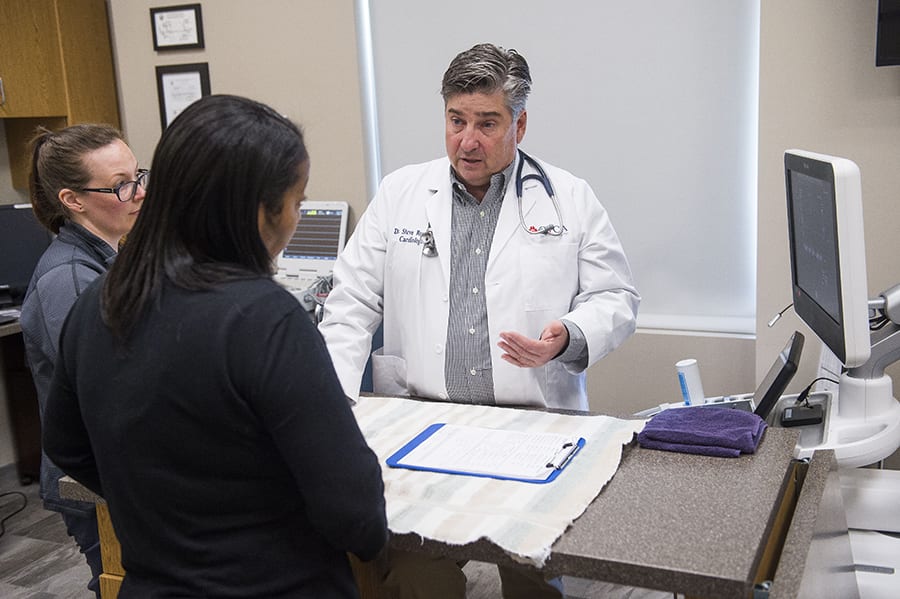Finding the Right Cancer Veterinary Near Me: A Pet Owner’s Checklist}
What You Required to Learn About Veterinary Providers: A Summary of Diagnostic Devices and Procedures
Vet services play an important duty in preserving the health of pets. Normal examinations can expose covert health concerns early on. Various analysis tools and procedures, such as blood tests and imaging techniques, supply crucial insights into a pet's wellness. Recognizing these techniques is essential for pet owners. What details diagnostic treatments are most generally utilized, and just how can they impact a family pet's therapy plan?
Significance of Normal Vet Check-Ups
While lots of pet dog owners may take too lightly the importance of normal veterinary examinations, these consultations are important for preserving a pet's total health. Routine sees to the vet permit for early detection of potential health and wellness problems prior to they rise right into serious problems. Routine exams often include vaccinations, which are very important for preventing contagious diseases that might severely impact an animal's wellness. In addition, these appointments offer a chance for vets to examine the animal's weight, dental health and wellness, and total problem, ensuring that the pet is prospering. During these check outs, pet owners can likewise receive important guidance on diet, exercise, and preventative treatment customized to their certain animal's needs.
Common Diagnostic Procedures in Veterinary Medication
In vet medicine, accurate medical diagnosis is crucial for reliable treatment. Usual diagnostic procedures consist of blood screening techniques, progressed imaging modern technologies, and urinalysis, each playing a substantial function in identifying wellness problems. Comprehending these methods enhances the capacity to supply suitable care for pet people.
Blood Examining Methods
Blood screening methods work as essential analysis devices in vet medication, making it possible for veterinarians to examine the wellness of pets properly. These strategies entail gathering blood examples to examine various parts, such as white and red blood cells, platelets, and biochemical markers. Typical examinations consist of total blood counts (CBC), which review overall wellness and discover infections, and biochemical panels, which assess organ feature and metabolic status. Furthermore, serological examinations can determine details diseases with antibody detection. Blood testing is minimally intrusive and provides critical information that helps in diagnosing conditions, keeping track of health condition, and evaluating actions to therapies. On the whole, these methods play a crucial role in making sure excellent care for family pets and animals alike.
Imaging Technologies Made Use Of
Diagnostic imaging technologies are vital devices in veterinary medicine, complementing blood testing methods by supplying aesthetic understandings right into a pet's inner frameworks. Common imaging modalities include X-rays, which serve for reviewing bone cracks and spotting international things, and ultrasound, which allows for real-time visualization of soft tissues and organs. Magnetic vibration imaging (MRI) offers comprehensive pictures of complicated physiological areas, especially in neurological analyses. Computed tomography (CT) provides cross-sectional images, enhancing diagnostic accuracy for various conditions. Each of these technologies aids veterinarians in detecting ailments, intending therapies, and checking recovery. By integrating imaging technologies, veterinary specialists can much better examine a pet's health and wellness and make informed choices concerning their care.
Urinalysis and Diagnostics
Urinalysis acts as a vital diagnostic device in vet medicine, giving beneficial understandings into an animal's total health and wellness and helping in the detection of various problems. This non-invasive procedure analyzes pee samples to analyze kidney feature, hydration status, and metabolic problems. Typical components examined consist of particular gravity, pH degrees, glucose, healthy proteins, and the existence of blood or bacteria. Irregular findings can show issues such as urinary system tract infections, diabetes mellitus, or kidney disease. To enhance analysis accuracy, urinalysis is often done in conjunction with various other tests, such as blood job and imaging researches. Early detection through urinalysis can bring about timely treatments, improving the diagnosis for numerous vet clients. For that reason, it is an important facet of complete veterinary care.
Recognizing Blood Tests and Research Laboratory Analysis
Comprehending blood tests and lab analysis is important in veterinary medicine as it helps in identifying different health and wellness conditions in pets. Various kinds of blood examinations provide crucial information regarding a pet's inner state, while interpreting lab results needs mindful factor to consider of various aspects. This area will explore the kinds of blood examinations available and the relevance of their results.
Kinds Of Blood Examinations
Blood examinations play an essential duty in veterinary medicine, supplying important insights into an animal's health standing. Numerous types of blood examinations are made use of, each offering different objectives. Total blood counts (CBC) examine overall health and wellness and find problems such as anemia or infection. Biochemical accounts assess organ function by measuring enzymes and electrolytes, providing insights into metabolic health and wellness. Serological tests determine certain antibodies or virus, aiding in the diagnosis of infections or autoimmune illness. Blood keying guarantees secure transfusions, while coagulation tests evaluate the blood's capability to clot, crucial for procedures. These examinations collectively enhance medical diagnosis, treatment planning, and monitoring of an animal's health and wellness, illustrating the value of thorough laboratory analysis in vet treatment.

Interpreting Laboratory Results
A comprehensive evaluation of laboratory results is necessary for exact diagnosis and therapy in vet medication. Interpreting lab results needs an understanding of regular reference varieties and the value of variances. Blood examinations can reveal different wellness indicators, such as organ function, electrolyte equilibrium, and the visibility of infections. Vets should consider the whole professional picture, consisting of the animal's history, physical evaluation findings, and any kind of signs and symptoms offered. Variants in outcomes may develop from elements such as age, type, and underlying health and wellness problems. Laboratory results should not be watched in isolation however rather as part of an all-encompassing analysis strategy. Precise interpretation enables tailored therapy plans and better outcomes for vet individuals.
Imaging Techniques: X-rays, Ultrasounds, and Beyond
Imaging techniques are crucial devices in veterinary medicine, giving crucial understandings right into the wellness and well-being of animals. Among one of the most commonly utilized methods are Ultrasounds and x-rays. X-rays are indispensable for envisioning bone frameworks, aiding veterinarians recognize fractures, lumps, or foreign objects. This approach is non-invasive and fast, making it ideal for immediate situations.Ultrasounds, on the various other hand, utilize sound waves to produce pictures of soft cells and body organs. This method is particularly useful for hop over to here examining the heart, abdominal area, and reproductive organs, permitting vets to assess problems like liquid buildup or body organ abnormalities.Beyond X-rays and ultrasounds, progressed imaging techniques such as computed tomography (CT) and magnetic vibration imaging (MRI) are progressively used in vet method. These techniques provide thorough cross-sectional photos, enhancing the accuracy of medical diagnoses and therapy strategies. Cancer Veterinary Near Me. In general, imaging methods play a crucial function in ensuring effective veterinary care
The Role of Biopsies in Diagnosing Pet Health Issues
Accuracy in detecting health issues in family pets commonly depends upon using biopsies, which provide definitive info concerning tissue abnormalities. A biopsy entails the removal of a tiny sample of cells for examination under a microscopic lense, permitting vets to recognize various problems, including infections, lumps, and inflammatory diseases. This analysis device is vital for distinguishing between benign and malignant developments, assisting therapy decisions, and assessing the severity of a condition.Biopsies can be done using various methods, such as needle aspiration, incisional biopsies, or excisional biopsies, depending upon the location recommended you read and type of cells entailed. The selection of approach may impact healing time and the quantity of cells accumulated. Ultimately, the details obtained from a biopsy can result in targeted therapies, improving end results for pet dogs encountering severe health difficulties. Vets highlight the value of this treatment in achieving exact diagnoses and effective therapy strategies.
Advanced Diagnostic Tools: Endoscopy and CT Checks

Advanced diagnostic devices, such as endoscopy and CT scans, play an important role in modern-day veterinary medication, supplying non-invasive techniques to visualize internal structures and detect different problems in pets. Endoscopy includes the use of a versatile tube outfitted with a camera, enabling vets to take a look at the intestinal system and breathing system directly. This method can expose problems such as lumps, international bodies, or swelling, allowing targeted treatment plans.CT scans, on the other hand, use innovative imaging innovation to produce Get More Information comprehensive cross-sectional photos of the body (Board Certified Veterinary Cardiologist). This technique is specifically valuable for reviewing complicated structures like the brain, back, and joints. By giving high-resolution pictures, CT scans help vets in determining problems that may not appear via typical radiography. Together, these innovative tools boost analysis precision, enhance therapy results, and inevitably add to much better general pet dog wellness monitoring

Translating Test Results: What Pet Owners Need To Know
Comprehending test results can be a tough job for animal owners, especially after advanced treatments like endoscopy and CT scans have been carried out. Analyzing these outcomes needs a grasp of clinical terms and a clear understanding of what the searchings for indicate concerning the animal's health. Vets frequently offer descriptions, yet the intricacy of the outcomes can still cause confusion.Pet owners ought to proactively participate in discussions with their veterinarians, asking concerns to make clear any kind of unpredictabilities. It is essential to comprehend abnormal versus regular outcomes and the implications for the pet dog's treatment plan. Additionally, acknowledging that some outcomes might require more screening or monitoring can aid owners stay informed regarding their pet dog's health journey. Inevitably, a joint approach between family pet proprietors and vet experts cultivates much better wellness outcomes and improves the general care experience for animals.
Often Asked Concerns
How Do I Choose the Right Veterinary Clinic for My Pet dog?
Picking the appropriate vet facility includes investigating regional choices, assessing qualifications, visiting centers, and assessing personnel interactions (Ultrasound For Dogs). Focusing on recommendations from trusted sources can help assure the most effective treatment and setting for an animal's health demands
What Should I Do if My Animal Rejects to visit the Veterinarian?
When a pet dog declines to go to the veterinarian, it's a good idea to remain tranquil, usage treats or toys to tempt them, and take into consideration setting up a home visit if anxiety lingers. Persistence and favorable support are key.
Exist Telehealth Options for Veterinary Providers?
Telehealth options for veterinary services are increasingly readily available, enabling family pet proprietors to talk to veterinarians remotely. These services enable discussions concerning wellness problems, suggestions on small conditions, and follow-ups without needing to go to a clinic.
How Often Should My Pet Have Oral Examinations?
The frequency of dental exams for pet dogs commonly depends upon their age and breed. Generally, vets advise annual dental analyses, although some family pets may require even more regular visits to keep excellent oral health.

What Are the Prices Associated With Veterinary Diagnostics?
The expenses related to vet diagnostics can vary widely, normally varying from standard examinations like blood work to advanced imaging methods. Elements affecting costs consist of the facility's place, devices used, and details examinations needed for each pet. Veterinary services play a crucial duty in keeping the wellness of pet dogs. While many pet owners may underestimate the value of routine veterinary examinations, these visits are necessary for keeping a pet's general health and wellness. Furthermore, these appointments offer an opportunity for veterinarians to assess the pet's weight, oral health and wellness, and general condition, guaranteeing that the animal is thriving. Precision in detecting wellness concerns in pet dogs usually pivots on the usage of biopsies, which give clear-cut info about cells problems. Furthermore, recognizing that some results might require further screening or tracking can help proprietors stay informed concerning their family pet's health and wellness journey.